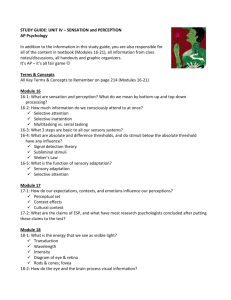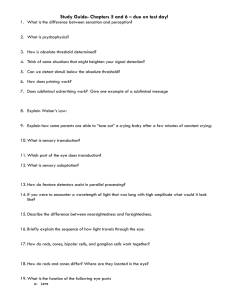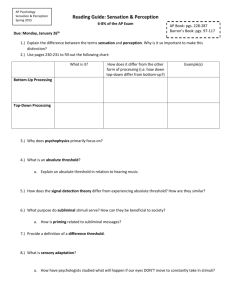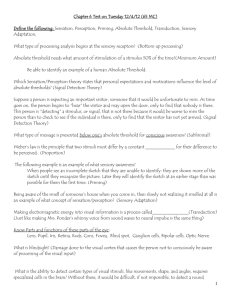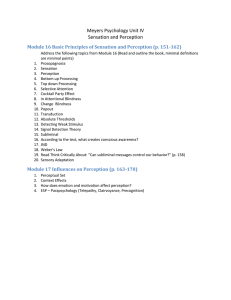Myers’ Psychology for AP , 2e ® David G. Myers
advertisement
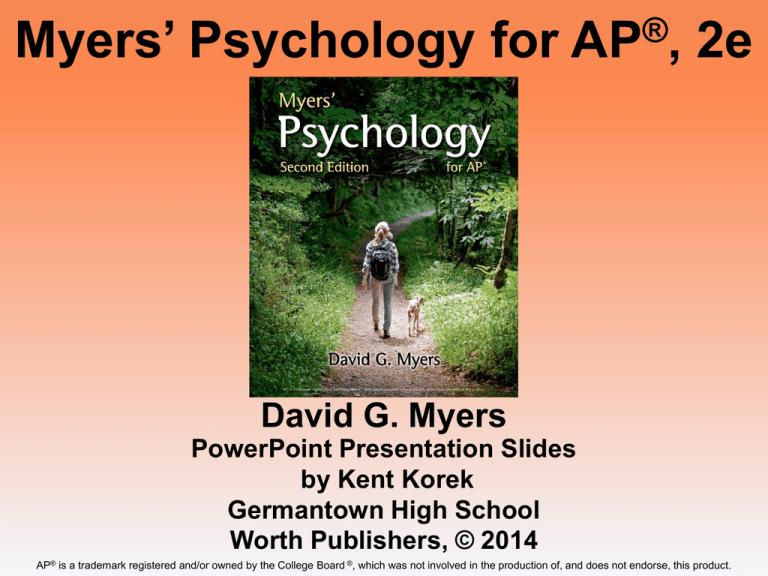
Myers’ Psychology for ® AP , 2e David G. Myers PowerPoint Presentation Slides by Kent Korek Germantown High School Worth Publishers, © 2014 AP® is a trademark registered and/or owned by the College Board ®, which was not involved in the production of, and does not endorse, this product. Unit 4: Sensation and Perception Unit 04 - Overview • Basic Principles of Sensation and Perception • Influences on Perception • Vision • Visual Organization and Interpretation • Hearing • The Other Senses Click on the any of the above hyperlinks to go to that section in the presentation. Module 16: Basic Principles of Sensation and Perception Introduction • Sensation • Perception –Are one continuous process Introduction • Bottom-up processing • Top-down processing Selective Attention Selective Attention • Selective Attention –Cocktail party effect Selective Attention Selective Attention and Accidents Selective Attention Selective Inattention • Inattentional blindness Selective Attention Selective Inattention • Change blindness Selective Attention Selective Inattention Change Blindness Selective Attention Selective Inattention Change Blindness Selective Attention Selective Inattention Change Blindness Selective Attention Selective Inattention Change Blindness Selective Attention Selective Inattention Change Blindness Selective Attention Selective Inattention Change Blindness Transduction Transduction • Transduction • Psychophysics Thresholds Thresholds Absolute Thresholds • Absolute threshold –50 % of the time • Signal detection theory Thresholds Absolute Thresholds • Subliminal –Cannot detect –Below absolute threshold • Priming –Masking stimulus Thresholds Difference Thresholds • Difference threshold –Just noticeable difference (jnd) • Weber’s Law –Constant minimum percentage • 50 ounce weights – 2 ounce jnd • 100 ounce weights – 4 ounce jnd Just noticeable difference Just noticeable difference Just noticeable difference Just noticeable difference Just noticeable difference Just noticeable difference Just noticeable difference Just noticeable difference Just noticeable difference Just noticeable difference Just noticeable difference Just noticeable difference Just noticeable difference Sensory Adaptation Sensory Adaptation • Sensory Adaptation –Informative changes –Reality versus usefulness Sensory Adaptation Emotion Adaptation Sensory Adaptation Emotion Adaptation Sensory Adaptation Emotion Adaptation Sensory Adaptation Emotion Adaptation Sensory Adaptation Emotion Adaptation Module 17: Influences on Perception Perceptual Set Perceptual Set • Perceptual set –Mental predisposition –Schemas Perceptual Set • Perceptual set –Mental predisposition –Schemas Perceptual Set • Perceptual set –Mental predisposition –Schemas Perceptual Set • Perceptual set –Mental predisposition –Schemas Perceptual Set • Perceptual set –Mental predisposition –Schemas From Leeper, R. W. (1935). A study of a neglected portion of the field of learning: The development of sensory organization. Journal of Genetic Psychology, 46, 41-75. Reprinted by permission of Taylor & Francis Ltd, http://www.tandf.co.uk/journals Context Effects Context Effects • Context effects Context Effects Context Effects Context Effects Emotion and Motivation Emotion and Motivation • Motivation on perception • Emotions on perception Module 18: Vision The Stimulus Input: Light Energy The Stimulus Input: Light Energy • Wavelength • Hue (color) –Wavelength • Intensity –Wave amplitude Electromagnetic Energy Spectrum Electromagnetic Energy Spectrum Electromagnetic Energy Spectrum The Physical Property of Waves The Physical Property of Waves The Physical Property of Waves The Physical Property of Waves The Physical Property of Waves The Eye The Eye • • • • Cornea Pupil Iris Lens –Accommodation • Retina The Structure of the Eye The Structure of the Eye Cornea = outer covering of the eye. The Structure of the Eye Pupil = the adjustable opening in the center of the eye through which light enters. The Structure of the Eye Iris = a ring of muscle tissue that forms the colored portion of the eye around the pupil and controls the size of the pupil opening. • The iris dilates/constricts in response to changing light intensity The Structure of the Eye Lens = the transparent structure behind the pupil that changes shape to help focus images on the retina. The Structure of the Eye Retina = the light-sensitive inner surface of the eye, containing the receptor rods and cones plus layers of neurons that begin the processing of visual information. The Eye The Retina • Rods and Cones Cones Rods The Eye The Retina The Retina’s Reaction to Light The Retina’s Reaction to Light The Retina’s Reaction to Light The Retina’s Reaction to Light The Retina’s Reaction to Light The Eye The Retina • Optic nerve • Blind spot • Fovea The Structure of the Eye Blind Spot = the point at which the optic nerve leaves the eye, creating a “blind” spot because no receptor cells are located there. The Structure of the Eye Fovea = the central focal point in the retina, around which the eye’s cones cluster. The Structure of the Eye Optic Nerve = the nerve that carries neural impulses from the eye to the brain. Visual Information Processing Visual Information Processing Visual Information Processing Visual Information Processing Visual Information Processing Visual Information Processing Visual Information Processing Feature Detection • Feature detectors Visual Information Processing Parallel Processing • Parallel processing –Blind sight Visual Information Processing Parallel Processing • Parallel processing –Blind sight Visual Information Processing Parallel Processing • Parallel processing –Blind sight Visual Information Processing Parallel Processing • Parallel processing –Blind sight Visual Information Processing Parallel Processing • Parallel processing –Blind sight Visual Information Processing Visual Information Processing Visual Information Processing Visual Information Processing Visual Information Processing Visual Information Processing Color Vision Color Vision • Young-Helmholtz trichromatic (three color) theory –Red – Green - Blue –Monochromatic vision –Dichromatic vision Color Vision • Opponent-process theory –Three sets of colors • Red-green • Blue-yellow • Black-white –Afterimage After image This slide is intentionally left blank. Module 19: Visual Organization and Interpretation Visual Organization Visual Organization • Gestalt (form or whole) Visual Organization Form Perception • Figure-ground Visual Organization Form Perception • Grouping –Proximity Visual Organization Form Perception • Grouping –Continuity Visual Organization Form Perception • Grouping –Closure Visual Organization Depth Perception • Depth perception –Visual-cliff Visual Organization Depth Perception: Binocular Cues • Binocular cues –Retinal disparity Visual Organization Depth Perception: Monocular Cues • Monocular cues –Horizontal-vertical illusion Visual Organization Depth Perception: Monocular Cues • Monocular cues –Relative height –Relative size –Interposition –Linear perspective –Relative motion –Light and shadow Visual Organization Depth Perception: Monocular Cues Relative Height Visual Organization Depth Perception: Monocular Cues Relative Size Visual Organization Depth Perception: Monocular Cues Interposition Visual Organization Depth Perception: Monocular Cues Linear Perspective Visual Organization Depth Perception: Monocular Cues Relative Motion Visual Organization Depth Perception: Monocular Cues Light and Shadow Visual Organization Motion Perception • Changing size of objects • Stroboscopic movement –Animated movies • 24 frames per second • Phi phenomenon – Lighted signs Visual Organization Perceptual Constancy • Perceptual Constancy Visual Organization Perceptual Constancy: Color and Brightness Constancies • Color constancy –Surrounding context –Surrounding objects Visual Organization Perceptual Constancy: Color and Brightness Constancies Visual Organization Perceptual Constancy: Color and Brightness Constancies • Lightness constancy –Brightness constancy –Relative luminance Visual Organization Perceptual Constancy: Color and Brightness Constancies Visual Organization Perceptual Constancy: Color and Brightness Constancies Visual Organization Perceptual Constancy: Shape and Size Constancies • Shape constancy Visual Organization Perceptual Constancy: Shape and Size Constancies • Size constancy –Moon illusion –Ames Room Visual Organization Perceptual Constancy: Shape and Size Constancies Ames Room Visual Organization Perceptual Constancy: Shape and Size Constancies Ames Room Visual Interpretation Visual Interpretation Experience and Visual Perception: Restored Vision and Sensory Restriction • Restored Vision • Critical period • Sensory deprivation Visual Interpretation Experience and Visual Perception: Perceptual Adaptation • Perceptual adaptation –Displacement goggles Module 20: Hearing The Stimulus Input: Sound Waves The Stimulus Input: Sound Waves • Audition • Amplitude –loudness • Frequency –Pitch The Ear The Ear • Outer ear –Auditory canal –Ear drum The Ear The ear is divided into the outer, middle and inner ear. The Ear The sound waves travel down the auditory canal to the eardrum. The Ear Eardrum = tight membrane that vibrates when struck by sound waves. The Ear Eardrum The Ear • Middle ear –Hammer, anvil, stirrup The Ear Bones of the middle ear = the hammer, anvil, stirrup which vibrate with the eardrum. The Ear Hammer The Ear Anvil The Ear Stirrup The Ear Oval window = where the stirrup connects to the cochlea. The Ear Cochlea = a coiled, body, fluid-filled tube in the inner ear through which sound waves trigger nerve impulses. The Ear • Inner ear – Oval window –Cochlea • Basilar membrane –Auditory nerve –Auditory cortex The Ear Oval Window The Ear Cochlea The Ear Fluid in the cochlea The Ear Hair cells in the cochlea The Ear Auditory nerve = nerve which sends the auditory message to the brain via the thalamus. The Ear Nerve fibers The Ear Auditory nerve The Ear Neural impulse travels to the auditory cortex in the brain. The Ear • Hearing loss –Conduction hearing loss –Sensorineural hearing loss –Cochlea implant • Signing The Ear Perceiving Loudness • Basilar membrane’s hair cells –Compressed sound The Ear Perceiving Loudness The Ear Perceiving Pitch • Place theory –High pitched sounds • Frequency theory –Low pitched sounds –Volley principle The Ear Locating Sounds • Stereophonic hearing • Localization of sounds –Intensity –Speed of the sound Module 21: The Other Senses Touch Touch • Types of touch –Pressure –Warmth –Cold –Pain • Sensation of hot Pain Pain Understanding Pain: Biological Influences • Biological Influences –Noiceptors –Gate-control theory –Endorphins –Phantom limb sensations –Tinnitus Pain Understanding Pain: Biological Influences Pain Understanding Pain: Biological Influences Pain Understanding Pain: Biological Influences Pain Understanding Pain: Biological Influences Pain Understanding Pain: Biological Influences Pain Understanding Pain: Psychological Influences • Psychological Influences –Memories of pain Pain Understanding Pain: Psychological Influences Biopsychosocial Approach Pain Understanding Pain: Psychological Influences Biopsychosocial Approach Pain Understanding Pain: Psychological Influences Biopsychosocial Approach Pain Understanding Pain: Psychological Influences Biopsychosocial Approach Pain Understanding Pain: Psychological Influences Biopsychosocial Approach Pain Understanding Pain: Social-Cultural Influences • Social-Cultural Influences Pain Controlling Pain • Physical methods • Psychological methods Taste Taste • Sweet, sour, salty and bitter –Umami • Taste buds –Chemical sense • Age and taste Smell Smell • Olfaction –Chemical sense –Odor molecules –Olfactory bulb –Olfactory nerve Smell (olfaction) Body Position and Movement Body Position and Movement • Kinesthesis • Vestibular sense –Semicircular canals Body Position and Movement Sensory Interaction Sensory Interaction • Sensory interaction • Interaction of smell and taste –McGurk Effect • Interaction of other senses • Embodied cognition – synesthesia The End Teacher Information • Types of Files – This presentation has been saved as a “basic” Powerpoint file. While this file format placed a few limitations on the presentation, it insured the file would be compatible with the many versions of Powerpoint teachers use. To add functionality to the presentation, teachers may want to save the file for their specific version of Powerpoint. • Animation – Once again, to insure compatibility with all versions of Powerpoint, none of the slides are animated. To increase student interest, it is suggested teachers animate the slides wherever possible. • Adding slides to this presentation – Teachers are encouraged to adapt this presentation to their personal teaching style. To help keep a sense of continuity, blank slides which can be copied and pasted to a specific location in the presentation follow this “Teacher Information” section. • Unit Coding Teacher Information – Just as Myers’ Psychology for AP 2e is color coded to the College Board AP Psychology Course Description (Acorn Book) Units, so are these Powerpoints. The primary background color of each slide indicates the specific textbook unit. • • • • • • • • • • • • • • Psychology’s History and Approaches Research Methods Biological Bases of Behavior Sensation and Perception States of Consciousness Learning Cognition Motivation, Emotion, and Stress Developmental Psychology Personality Testing and Individual Differences Abnormal Psychology Treatment of Abnormal Behavior Social Psychology Teacher Information • Hyperlink Slides - This presentation contain two types of hyperlinks. Hyperlinks can be identified by the text being underlined and a different color (usually purple). – Unit subsections hyperlinks: Immediately after the unit title and module title slide, a page can be found listing all of the unit’s subsections. While in slide show mode, clicking on any of these hyperlinks will take the user directly to the beginning of that subsection. – Bold print term hyperlinks: Every bold print term from the unit is included in this presentation as a hyperlink. While in slide show mode, clicking on any of the hyperlinks will take the user to a slide containing the formal definition of the term. Clicking on the “arrow” in the bottom left corner of the definition slide will take the user back to the original point in the presentation. These hyperlinks were included for teachers who want students to see or copy down the exact definition as stated in the text. Most teachers prefer the definitions not be included to prevent students from only “copying down what is on the screen” and not actively listening to the presentation. For teachers who continually use the Bold Print Term Hyperlinks option, please contact the author using the email address on the next slide to learn a technique to expedite the returning to the original point in the presentation. Teacher Information • Continuity slides – Throughout this presentation there are slides, usually of graphics or tables, that build on one another. These are included for three purposes. • By presenting information in small chunks, students will find it easier to process and remember the concepts. • By continually changing slides, students will stay interested in the presentation. • To facilitate class discussion and critical thinking. Students should be encouraged to think about “what might come next” in the series of slides. • Please feel free to contact me at kkorek@germantown.k12.wi.us with any questions, concerns, suggestions, etc. regarding these presentations. Kent Korek Germantown High School Germantown, WI 53022 262-253-3400 kkorek@germantown.k12.wi.us Division title (red print) subdivision title (blue print) • xxx –xxx –xxx Division title (red print in text) subdivision title (blue print in text) Use this slide to add a table, chart, clip art, picture, diagram, or video clip. Delete this box when finished Definition Slide = add definition here Definition Slides Sensation = the process by which our sensory receptors and nervous system receive and represent stimulus energies from our environment. Perception = the process of organizing and interpreting sensory information, enabling us to recognize meaningful objects and events. Bottom-Up Processing = analysis that begins with the sensory receptors and works up to the brain’s integration of sensory information. Top-Down Processing = information processing guided by higherlevel mental processes, as when we construct perceptions drawing on our experience and expectations. Selective Attention = the focusing of conscious awareness on a particular stimulus. Inattentional Blindness = failing to see visible objects when our attention is directed elsewhere. Change Blindness = failing to notice changes in the environment Transduction = conversion of one form of energy into another. In sensation, the transforming of stimulus energies, such as sights, sounds, and smells into neural impulses our brains can interpret. Psychophysics = the study of relationships between the physical characteristics of stimuli, such as their intensity, and our psychological experience of them. Absolute Threshold = the minimum stimulation necessary to detect a particular stimulus 50% of the time. Signal Detection Theory = a theory predicting how and when we detect the presence of a faint stimulus (signal) amid background stimulation (noise). Assumes there is no single absolute threshold and that detection depends partly on a person’s experience, expectations, motivation, and alertness. Subliminal = below one’s absolute threshold for conscious awareness. Priming = the activation, often unconsciously, of certain associations, thus predisposing one’s perception, memory, or response. Difference Threshold = the minimum difference between two stimuli required for detection 50 percent of the time. We experience the difference threshold as a just noticeable difference (jnd). Weber’s Law = the principle that, to be perceived as different, two stimuli must differ by a constant minimum percentage (rather than a constant amount). Sensory Adaptation = diminished sensitivity as a consequence of constant stimulation. Perceptual Set = a mental disposition to perceive one thing and not another. Extrasensory Perception (ESP) = the controversial claim that perception can occur apart from sensory input; includes telepathy, clairvoyance, and precognition. Parapsychology = the study of paranormal phenomena, including ESP and psychokinesis. Wavelength = the distance from the peak of one light or sound wave to the peak of the next. Electromagnetic wavelengths vary from the short blips of comic rays to the long pulses of radio transmission. Hue = the dimension of color that is determined by the wavelength of light; what we know as the color names blue, green, and so forth. Intensity = the amount of energy in a light or sound wave, which we perceive as brightness or loudness, as determined by the wave’s amplitude. Pupil = the adjustable opening in the center of the eye through which lights enters. Iris = a ring of muscle tissue that forms the colored portion of the eye around the pupil and controls the size of the pupil opening. Lens = the transparent structure behind the pupil that changes shape to help focus the images on the retina. Retina = the light-sensitive inner surface of the eye, containing the receptor rods and cones plus layers of neurons that begin the processing of visual information. Accommodation = the process by which the eye’s lens changes shape to focus near or far objects on the retina. Rods = retinal receptors that detect black, white, and gray; necessary for peripheral and twilight vision, when cones don’t respond. Cones = retinal receptor cells that are concentrated near the center of the retina and that function in daylight or in well-lit conditions. The cones detect fine detail and give rise to color sensations. Optic Nerve = the nerve that carries neural impulses from the eye to the brain. Blind Spot = the point at which the optic nerve leaves the eye, creating a “blind” spot because no receptor cells are located there. Fovea = the central focal point in the retina, around the which the eye’s cones cluster. Feature Detectors = nerve cells in the brain that respond to specific features of the stimulus, such as shape, angle, or movement. Parallel Processing = the processing of many aspects of a problem simultaneously; the brain’s natural mode of information processing for many functions, including vision. • Contrasts with the step-by-step (serial) processing of most computers and of conscious problem solving. Young-Helmholtz Trichromatic (three-color) Theory = the theory that the retina contains three different color receptors – one most sensitive to red, one to green, one to blue – which, when stimulated in combination can produce the perception of any color. Opponent-Process Theory = the theory that opposing retinal processes (red-green, yellow-blue, white-black) enable color vision. For example, some cells are stimulated by green and inhibited by red; others are stimulated by red and inhibited by green. Gestalt = an organized whole. Gestalt psychologists emphasized our tendency to integrate pieces of information into meaningful wholes. Figure-Ground = the organization of the visual field into objects (the figures) that stand out from their surroundings (the ground). Grouping = the perceptual tendency to organize stimuli into coherent groups. Depth Perception = the ability to see objects in three dimensions although the images that strike the retina are two-dimensional; allows us to judge distance. Visual Cliff = a laboratory device for testing depth perception in infants and young animals. Binocular Cues = depth cues, such as retinal disparity, that depend on the use of two eyes. Retinal Disparity = a binocular cue for perceiving depth. By comparing images from the retinas in the two eyes, the brain computes distance – the greater the disparity (difference) between the two images, the closer the object. Monocular Cues = depth cues, such as interposition and linear perspective, available to either eye alone. Phi Phenomenon = an illusion of movement created when two or more adjacent lights blink on and off in quick succession. Perceptual Constancy = perceiving objects as unchanging (having consistent shapes, size, lightness, and color) even as illumination and retinal images change. Color Constancy = perceiving familiar objects as having consistent color, even if changing illumination alters the wavelengths reflected by the object. Perceptual Adaptation = in vision, the ability to adjust to an artificially displaced or even inverted visual field. Audition = the sense or act of hearing. Frequency = the number of complete wavelengths that pass a point in a given time (i.e. per second). Pitch = a tone’s experienced highness or lowness; depends on frequency. Middle Ear = the chamber between the eardrum and cochlea containing three tiny bones (hammer, anvil, and stirrup) that concentrate the vibrations of the eardrum on the cochlea’s oval window. Cochlea = a coiled, bony, fluid-filled tube in the inner ear; sound waves traveling through the cochlea trigger nerve impulses. Inner Ear = the innermost part of the ear, containing the cochlea, semicircular canals, and vestibular sacs. Sensorineural Hearing Loss = hearing loss caused by damage to the cochlea’s receptor cells or to the auditory nerves; also called nerve deafness. Conduction Hearing Loss = hearing loss caused by damage to the mechanical system that conducts sound waves to the cochlea. Cochlea Implant = a device for converting sounds into electrical signals and stimulating the auditory nerve through electrodes threaded into the cochlea. Place Theory = in hearing, the theory that links the pitch we hear with the place where the cochlea’s membrane is stimulated. Frequency Theory = in hearing, the theory that the rate of nerve impulses traveling up the auditory nerve matches the frequency of a tone, thus enabling us to sense its pitch. Gate-Control Theory = the theory that the spinal cord contains a neurological “gate” that blocks pain signals or allows them to pass on to the brain. The “gate” is opened by the activity of pain signals traveling up small nerve fibers and is close by activity in larger fibers or by information coming from the brain. Kinethesia = the system for sensing the position and movement of individual body parts. Vestibular Sense = the sense of body movement and position, including the sense of balance. Sensory Interaction = the principle that one sense may influence another, as when the smell of food influences its taste. Embodied Cognition = in psychological science, the influence of bodily sensations, gestures, and other states of cognitive preferences and judgments.

